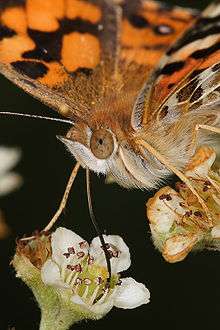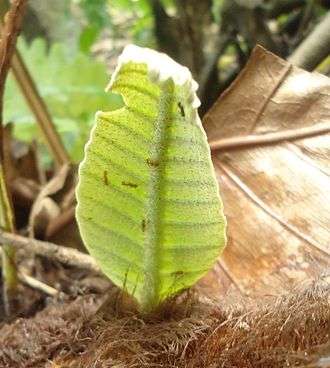Nectar



Nectar is a sugar-rich liquid produced by plants in glands called nectaries, either within the flowers with which it attracts pollinating animals, or by extrafloral nectaries, which provide a nutrient source to animal mutualists, which in turn provide antiherbivore protection. Common nectar-consuming pollinators include bees, butterflies and moths, hummingbirds, and bats. Nectar plays an important role in the foraging economics and overall evolution of nectar-eating species; for example, nectar and its properties are responsible for the differential evolution of the African honey bee, A. m. scutellata and the western honey bee.
Nectar is an ecologically important item, the sugar source for honey. It is also useful in agriculture and horticulture because the adult stages of some predatory insects feed on nectar. For example, the social wasp species Apoica flavissima relies on nectar as a primary food source. In turn, these wasps then hunt agricultural pest insects as food for their young. For example, thread-waisted wasps (genus Ammophila) are known for hunting caterpillars that are destructive to crops.
Nectar secretion increases as the flower is visited by pollinators. After pollination, the nectar is frequently reabsorbed into the plant.[1]
Etymology
Nectar is derived from Greek nektar, the favored drink of the gods. The current meaning, "sweet liquid in flowers," is first recorded in AD 1600.[2]
Floral nectaries
Floral nectaries are generally located at the base of the perianth, so pollinators are made to brush the flower's reproductive structures, the stamen and pistil, while accessing the nectar.
Septal nectaries
A septal nectary is nectar-producing tissue that is found in the wall of a plant ovary.[3] Septal nectaries function as a way of attracting pollinators.[4] Plants that rely on insects, birds, or bats for pollination often have septal nectaries. Aside from attracting pollinators, septal nectaries have also been known to attract "plant protectors." Some plants, like Ruellia radicans, have nectaries that continue to secrete pollen even after the petals have been shed. This attracts ants which will in turn protect the developing fruits of the plant from seed predators and herbivores in exchange for nectar.[5]
Extrafloral nectaries
Extrafloral nectaries (also known as extranuptial nectaries) are nectar-secreting plant glands that develop outside of flowers and are not involved in pollination.[6] They are highly diverse in form, location, size, and mechanism. They have been described in virtually all above-ground plant parts—including leaves (in which case they are known as foliar nectaries), petioles, stipules, cotyledons, fruits, and stems, among others. They range from single-celled trichomes to complex cup-like structures that may or may not be vascularized.[7]


In contrast to floral nectaries, nectar produced outside the flower generally have a defensive function. The nectar attracts predatory insects which will eat both the nectar and any plant-eating insects around, thus functioning as 'bodyguards'.[8] Foraging predatory insects show a preference for plants with extrafloral nectaries, particularly some species of ants and wasps, which have been observed to directly defend the plants.[6] Among passion flowers, for example, extrafloral nectaries prevent herbivores by attracting ants and deterring two species of butterflies from laying eggs.[9] In many carnivorous plants, extrafloral nectaries are also used to attract insect prey.[10]
Extrafloral nectaries were originally believed to simply be excretory in nature (hydathodes). Their defensive functions were first recognized by the Italian botanist Federico Delpino in his important monograph Funzione mirmecofila nel regno vegetale (1886). Delpino's study was inspired by a disagreement with Charles Darwin, with whom he corresponded regularly. Darwin believed extrafloral nectaries were simply hydathodes, while Delpino believed they had a defensive function, especially among myrmecophilic plants.[11]
Extrafloral nectaries have been reported in over 3941 species of vascular plants belonging to 745 genera and 108 families, 99.7% of which belong to flowering plants (angiosperms), comprising 1.0 to 1.8% of all known species. They are most common among eudicots, occurring in 3642 species (of 654 genera and 89 families), particularly among rosids which comprise more than half of the known occurrences. The families showing the most recorded occurrences of extrafloral nectaries are Fabaceae, with 1069 species, Passifloraceae, with 438 species, and Malvaceae, with 301 species. The genera with the most recorded occurrences are Passiflora (322 species, Passifloraceae), Inga (294 species, Fabaceae), and Acacia (204 species, Fabaceae).[7] Other genera with extrafloral nectaries include Salix (Salicaceae), Prunus (Rosaceae) and Gossypium (Malvaceae).[9]
Foliar nectaries have also been observed in 39 species of ferns belonging to seven genera and four families of Cyatheales and Polypodiales.[7] They are absent, however, in bryophytes, gymnosperms, early angiosperms, magnoliids, and members of Apiales among the eudicots.[7] Phylogenetic studies and the wide distribution of extrafloral nectaries among vascular plants point to multiple independent evolutionary origins of extrafloral nectaries in at least 457 independent lineages.[7]
Natural components
Although its main ingredient is natural sugar in a proportion of approximately 55% sucrose, 24% glucose and 21% fructose,[12] nectar is a brew of many chemicals.[13] For example, the Nicotiana attenuata, a tobacco plant native to the US state of Utah, uses several volatile aromas to attract pollinating birds and moths. The strongest such aroma is benzylacetone, but the plant also adds bitter nicotine, which is less aromatic, so may not be detected by the bird until after taking a drink. Researchers speculate the purpose of this addition is to discourage the forager after only a sip, motivating it to visit other plants, therefore maximizing the pollination efficiency gained by the plant for a minimum nectar output.[13][14] Neurotoxins such as aesculin are present in some nectars such as that of the California buckeye.[15] Nectar contains water, carbohydrates, amino acids, ions and numerous other compounds.[1][13]
See also
References
- 1 2 - Amino Acids. Robert Thornburg, 04/06/01, Iowa state University. Accessed April 2011
- ↑ Douglas Harper. "Online Etymology Dictionary". Retrieved 2007-09-26.
- ↑ Judd, Walter S., Christopher S. Campbell, Elizabeth L. Kellog, Peter F. Stevens, and Michael J. Donoghue. Plant systematics a phylogenetic approach. 3rd ed. Sunderland, MA: Sinauer Associates, Inc., 2007.
- ↑ Sajo, M. G.; Rudall, P. J.; Prychid, C. J. (2004). "Floral anatomy of Bromeliaceae, with particular reference to the evolution of epigyny and septal nectaries in commelinid monocots". Plant Systematics and Evolution. 247 (3–4). doi:10.1007/s00606-002-0143-0.
- ↑ Gracie, C. (The New York Botanical Garden, Bronx, NY 10458-5126). Observation of dual function of nectaries in Ruellia radicans (Nees) Lindau (Acanthaceae). Bull. Torrey Bot. Club 118: 188-190. 1991.
- 1 2 Heil, M.; Fiala, B.; Baumann, B.; Linsenmair, K.E. (2000). "Temporal, spatial and biotic variations in extrafloral nectar secretion by Macaranga tanarius". Functional Ecology. 14 (6): 749. doi:10.1046/j.1365-2435.2000.00480.x.
- 1 2 3 4 5 Weber, M. G.; Keeler, K. H. (2012). "The phylogenetic distribution of extrafloral nectaries in plants". Annals of Botany. doi:10.1093/aob/mcs225.
- ↑ Plant-Provided Food for Carnivorous Insects - Cambridge University Press
- 1 2 Sezen, Uzay. "Ants defending extrafloral nectaries of the passion flower (Passiflora incarnata)". Retrieved 6 January 2012.
- ↑ Merbach, M. 2001. Nectaries in Nepenthes. In: C.M. Clarke Nepenthes of Sumatra and Peninsular Malaysia. Natural History Publications (Borneo), Kota Kinabalu.
- ↑ Mancuso, S. (2010). "Federico Delpino and the foundation of plant biology". Plant Signaling & Behavior. 5 (9): 1067–1071. doi:10.4161/psb.5.9.12102.
- ↑ Stahl, J. M.; Nepi, M; Galetto, L; Guimarães, E; Machado, S. R. (2012). "Functional aspects of floral nectar secretion of Ananas ananassoides, an ornithophilous bromeliad from the Brazilian savanna". Annals of Botany. 109 (7): 1243–52. doi:10.1093/aob/mcs053. PMC 3359915
 . PMID 22455992.
. PMID 22455992. - 1 2 3 Nicolson, Susan W.; Nepi, Massimo (2007). Pacini, Ettore, ed. "Nectaries and Nectar; Nectar Components". Springer Publications. pp. 8–9. ISBN 9781402059377.
- ↑ Chemical & Engineering News, Vol. 86 No. 35, 1 Sept. 2008, "Two-Faced Flowers", p. 11
- ↑ C.Michael Hogan (2008) Aesculus californica, Globaltwitcher.com, ed. N. Stromberg
Bibliography
- Baker, H.G. and Baker, I. (1973) Amino acids in nectar and their evolutionary significance. Nature 241:543–545.
- Baker, H.G. and Baker, I. (1981) Chemical constituents of nectar in relation to pollination mechanisms and phylogeny. In Biochemical aspects of evolutionary biology. 131–171.
- Baker, H.G. and Baker, I. (1975) Studies of nectar-constitution and pollinator-plant coevolution. In Coevolution of animals and plants. Gilbert, L.E. and Raven, P.H. ed. Univ. of Texas Press, Austin, 100–140.
- Beutler, R. (1935) Nectar. Bee World 24:106–116, 128–136, 156–162.
- Burquez, A. and Corbet, S.A. (1991) Do flowers reabsorb nectar? Funct. Ecol. 5:369–379.
- Carter, C., Graham, R. and Thornburg, R.W. (1999) Nectarin I is a novel, soluble germin-like protein expressed in the nectar of Nicotiana sp. Plant Mol. Biol. 41:207–216.
- Deinzer, M.L.,tomson p.m, Burgett, D.M. and Isaacson, D.L. (1977) Pyrrolizidine alkaloids: Their occurrence in honey from tansy ragwort (Senecio jacobaea L.). Science 195:497–499.
- Ecroyd, C.E., Franich, R.A., Kroese, H.W. and Steward, D. (1995) Volatile constituents of Dactylanthus taylorii flower nectar in relation to flower pollination and browsing by animals. Phytochemistry 40:1387–1389.
- Esau, K. (1977) Anatomy of seed plants. John Wiley & Sons, New York.
- Ferreres, F., Andrade, P., Gil, M.I. and Tomas Barberan, F.A. (1996) Floral nectar phenolics as biochemical markers for the botanical origin of heather honey. Zeitschrift fur Lebensmittel Untersuchung und Forschung. 202:40–44.
- Frey-Wyssling, A. (1955) The phloem supply to the nectaries. Acta Bot. Neerl. 4:358–369.
- Griebel, C. and Hess, G. (1940) The vitamin C content of flower nectar of certain Labiatae. Zeit. Untersuch. Lebensmitt. 79:168–171.
- Heinrich, G. (1989) Analysis of cations in nectars by means of a laser microprobe mass analyser (LAMMA). Beitr. Biol. Pflanz64:293–308.
- Heslop-Harrison, Y. and Knox, R.B. (1971) A cytochemical study of the leaf-gland enzymes of insectivorus plants of the genusPinguicula. Planta 96:183–211.
- Peumans, W.J., Smeets, K., Van Nerum, K., Van Leuven, F. and Van Damme, E.J.M. (1997) Lectin and alliinase are the predominant proteins in nectar from leek (Allium porrum L.) flowers. Planta 201:298–302.
- Rodriguez-Arce, A.L. and Diaz, N. (1992) The stability of beta-carotene in mango nectar. J. Agric. Univ. P.R. Rio Piedras, P.R.76:101–102.
- Roshchina, V.V. and Roshchina, V.D. (1993) The excretory function of higher plants. Springer-Verlag, Berlin.
- Scala, J., Iott, K., Schwab, W. and Semersky, F.E. (1969) Digestive secretion of Dionaea muscipula (Venus's-Flytrap). Plant Physiol. 44:367–371.
- Smith, L.L., Lanza, J. and Smith, G.C. (1990) Amino acid concentrations in extrafloral nectar of Impatiens sultani increase after simulated herbivory. Ecol. Publ. Ecol. Soc. Am. 71:107–115.
- Vogel, S. (1969) Flowers offering fatty oil instead of nectar. Abstracts XIth Internatl. Bot. Congr. Seattle.
External links
| Wikimedia Commons has media related to Nectar. |
- Overview and summary of the honey bee (and Nectar) information. (News, Economy, Trade, Problems, etc)
- Hummingbird Plants Database